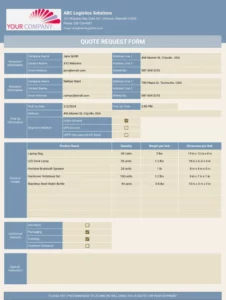Utilizing such a form streamlines the process of obtaining transportation costs, saving time and reducing potential misunderstandings. This structured approach promotes transparency and facilitates fair competition among carriers. The readily available data within these forms also aids in budgeting and financial forecasting, enabling businesses to accurately project transportation expenses. Ultimately, this contributes to efficient logistics management and improved profitability.
The following sections will delve into the key components of these forms, best practices for their completion, and strategies for leveraging them to secure optimal freight rates.
Key Components of a Freight Quote Request
Effective freight quote requests require specific information to ensure accurate pricing and efficient communication. The following components are essential:
1. Shipper Information: Complete details of the party initiating the shipment, including company name, address, contact person, and contact information.
2. Consignee Information: Complete details of the party receiving the shipment, including company name, address, contact person, and contact information.
3. Origin and Destination Details: Precise addresses for both pickup and delivery locations, including zip codes and any specific access instructions.
4. Shipment Details: A comprehensive description of the goods being shipped, including the type of commodity, total weight, dimensions (length, width, height), number of pieces, and packaging type. Hazardous materials require specific documentation and handling instructions.
5. Service Requirements: Specification of the required transportation mode (e.g., truckload, less-than-truckload, intermodal, air, ocean) and any additional services needed, such as liftgate service, inside delivery, or temperature control.
6. Desired Pickup and Delivery Dates: Clear indication of the preferred pickup and delivery timeframe, noting any flexibility or specific deadlines.
7. Freight Class (if applicable): For LTL shipments, the freight class determines the pricing category based on factors like density, handling, and liability. Accurate classification is crucial for obtaining the correct quote.
8. Special Instructions: Any specific instructions or requirements related to the shipment, such as delivery appointment scheduling, specific handling procedures, or required documentation.
Accurate and comprehensive information within these fields enables carriers to provide precise and timely quotes, facilitating efficient transportation planning.
How to Create a Freight Quote Request Template
Creating a standardized template ensures consistency, efficiency, and clarity in soliciting freight quotes. A well-designed template facilitates accurate pricing and comparison across multiple carriers. The following steps outline the process of creating a comprehensive template.
1. Template Format: Select a suitable format, such as a spreadsheet, word processing document, or online form. Ensure the chosen format allows for clear organization and easy data entry.
2. Shipper and Consignee Sections: Designate distinct sections for shipper and consignee information. Include fields for company name, full address, contact person, phone number, and email address.
3. Shipment Details Section: Create a detailed section for capturing all relevant shipment information. Include fields for commodity type, weight, dimensions (length, width, height), number of pieces, packaging type, and hazardous material designations (if applicable).
4. Origin and Destination Section: Include dedicated fields for complete pickup and delivery addresses, including zip codes, and any specific access instructions (e.g., limited access, delivery restrictions).
5. Service Requirements Section: Provide options for specifying the required transportation mode (truckload, less-than-truckload, intermodal, etc.) and any additional services (liftgate, inside delivery, temperature control).
6. Scheduling Section: Incorporate fields for desired pickup and delivery dates and times, along with any flexibility or specific deadlines.
7. Freight Class and Special Instructions: Include a field for freight class (essential for LTL shipments) and a dedicated space for any special instructions or handling requirements.
8. Optional Fields: Consider adding optional fields for information such as purchase order numbers, insurance requirements, or preferred carriers.
A standardized template, incorporating these components, streamlines the quote request process, minimizes errors, and allows for efficient comparison of carrier responses. Regular review and updates ensure the template remains aligned with evolving business needs.
Standardized forms for soliciting transportation pricing offer a crucial tool for efficient supply chain management. Accuracy and comprehensiveness in these forms ensures clear communication with carriers, enabling precise cost estimations and informed decision-making. From detailed shipment descriptions and service requirements to specific origin and destination details, each component contributes to a streamlined process. Leveraging well-structured templates saves time, minimizes errors, and promotes transparency in securing competitive freight rates. Ultimately, optimized transportation cost management contributes to enhanced profitability and overall business success.
Effective management of transportation expenses requires a proactive and informed approach. Adopting standardized procedures, utilizing comprehensive templates, and fostering clear communication with carriers are essential steps toward achieving this goal. As supply chains continue to evolve in complexity, the strategic use of these tools will become increasingly critical for maintaining a competitive edge in the marketplace.
